
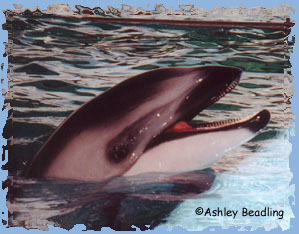 Pacific White-sided dolphins are one of the more acrobatic and social of the "lags", dolphins that have a short, blunt rostrum. They are found only in the waters of the northern Pacific Ocean, their range stretching up the California coast into British Columbia and also to Japan, staying in temperate waters. These dolphins are usually seen offshore, or along the edge of the continental shelf, though they may come closer to shore in deeper waters made by underwater canyons.
Pacific White-sided dolphins are one of the more acrobatic and social of the "lags", dolphins that have a short, blunt rostrum. They are found only in the waters of the northern Pacific Ocean, their range stretching up the California coast into British Columbia and also to Japan, staying in temperate waters. These dolphins are usually seen offshore, or along the edge of the continental shelf, though they may come closer to shore in deeper waters made by underwater canyons.
Resembling the Dusky dolphin, though the two species never mix, the Pacific White-sided dolphin is characterized by the white underside of the body, with light grey along the sides, and a dark grey or black coloring on the top.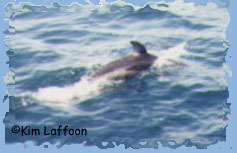 The tip of their rostrum is black, and a grey patch comes back to make a circle around their eyes. Also, the front edge of their dorsal and pectoral fins are black or dark grey, with the trailing edge more often a paler grey shade, making them a very complex looking dolphin.
The tip of their rostrum is black, and a grey patch comes back to make a circle around their eyes. Also, the front edge of their dorsal and pectoral fins are black or dark grey, with the trailing edge more often a paler grey shade, making them a very complex looking dolphin.
Pacific white-sided dolphins have anywhere from 84 to 128 sharply pointed teeth that are slightly curved. In fact, their species name "obliquidens" means "slanting tooth." Fish and squid make up most of their diet, and these sharp teeth are ideal for gripping their slippery food.
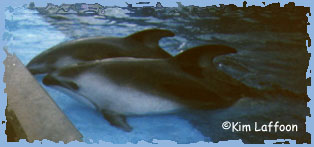 Pods may range in groups of one hundred, though when feeding, these split up into smaller groups. Sights of several thousand are common but mostly occur offshore. When they get together, the disturbance in the water is plain to see from all their splashing.
Pods may range in groups of one hundred, though when feeding, these split up into smaller groups. Sights of several thousand are common but mostly occur offshore. When they get together, the disturbance in the water is plain to see from all their splashing.
They are very social animals, full of curiousity, and will readily approach boats to have a look or bow ride. They also love to ride the wakes of boats, or even surf ocean waves. 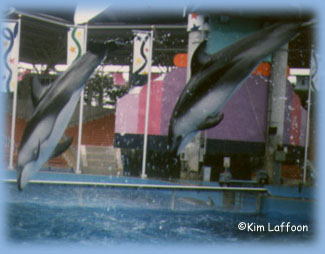 Breaching is a very common behavior, and sometimes the dolphins will spin in midair or even turn a complete flip in the air. These dolphins are very powerful swimmers, and can often be seen porpoising as they come up to breathe when traveling at a high speed.
Breaching is a very common behavior, and sometimes the dolphins will spin in midair or even turn a complete flip in the air. These dolphins are very powerful swimmers, and can often be seen porpoising as they come up to breathe when traveling at a high speed.
Sometimes Pacific White-sided dolphins can be seen associating with other species of marine mammals. They seem to enjoy the company of Northern Right Whale dolphins, and may also sometimes associate with seals and sea lions.
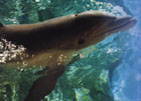



 Pacific White-sided dolphins are one of the more acrobatic and social of the "lags", dolphins that have a short, blunt rostrum. They are found only in the waters of the northern Pacific Ocean, their range stretching up the California coast into British Columbia and also to Japan, staying in temperate waters. These dolphins are usually seen offshore, or along the edge of the continental shelf, though they may come closer to shore in deeper waters made by underwater canyons.
Pacific White-sided dolphins are one of the more acrobatic and social of the "lags", dolphins that have a short, blunt rostrum. They are found only in the waters of the northern Pacific Ocean, their range stretching up the California coast into British Columbia and also to Japan, staying in temperate waters. These dolphins are usually seen offshore, or along the edge of the continental shelf, though they may come closer to shore in deeper waters made by underwater canyons.
 The tip of their rostrum is black, and a grey patch comes back to make a circle around their eyes. Also, the front edge of their dorsal and pectoral fins are black or dark grey, with the trailing edge more often a paler grey shade, making them a very complex looking dolphin.
The tip of their rostrum is black, and a grey patch comes back to make a circle around their eyes. Also, the front edge of their dorsal and pectoral fins are black or dark grey, with the trailing edge more often a paler grey shade, making them a very complex looking dolphin.
 Pods may range in groups of one hundred, though when feeding, these split up into smaller groups. Sights of several thousand are common but mostly occur offshore. When they get together, the disturbance in the water is plain to see from all their splashing.
Pods may range in groups of one hundred, though when feeding, these split up into smaller groups. Sights of several thousand are common but mostly occur offshore. When they get together, the disturbance in the water is plain to see from all their splashing.
 Breaching is a very common behavior, and sometimes the dolphins will spin in midair or even turn a complete flip in the air. These dolphins are very powerful swimmers, and can often be seen porpoising as they come up to breathe when traveling at a high speed.
Breaching is a very common behavior, and sometimes the dolphins will spin in midair or even turn a complete flip in the air. These dolphins are very powerful swimmers, and can often be seen porpoising as they come up to breathe when traveling at a high speed.